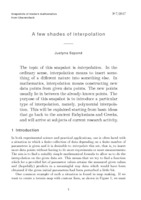| dc.contributor.author | Szpond, Justyna | |
| dc.contributor.editor | Munday, Sara | |
| dc.contributor.editor | Niediek, Johannes | |
| dc.contributor.editor | Cederbaum, Carla | |
| dc.date.accessioned | 2017-12-07T10:51:11Z | |
| dc.date.available | 2017-12-07T10:51:11Z | |
| dc.date.issued | 2017-12-07 | |
| dc.identifier.uri | http://publications.mfo.de/handle/mfo/1329 | |
| dc.description.abstract | The topic of this snapshot is interpolation. In the
ordinary sense, interpolation means to insert something
of a different nature into something else. In
mathematics, interpolation means constructing new
data points from given data points. The new points
usually lie in between the already-known points. The
purpose of this snapshot is to introduce a particular
type of interpolation, namely, polynomial interpolation.
This will be explained starting from basic ideas
that go back to the ancient Babylonians and Greeks,
and will arrive at subjects of current research activity. | en_US |
| dc.language.iso | en | en_US |
| dc.publisher | Mathematisches Forschungsinstitut Oberwolfach | en_US |
| dc.relation.ispartofseries | Snapshots of modern mathematics from Oberwolfach;2017,07 | |
| dc.rights | Attribution-ShareAlike 4.0 International | * |
| dc.rights.uri | http://creativecommons.org/licenses/by-sa/4.0/ | * |
| dc.title | A few shades of interpolation | en_US |
| dc.type | Article | en_US |
| dc.identifier.doi | 10.14760/SNAP-2017-007-EN | |
| local.series.id | SNAP-2017-007-EN | |
| local.subject.snapshot | Algebra and Number Theory | |
| local.subject.snapshot | Geometry and Topology | |
| dc.identifier.urn | urn:nbn:de:101:1-2017120722292 | |
| dc.identifier.ppn | 1657364968 | |


